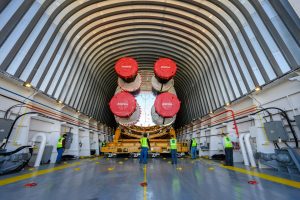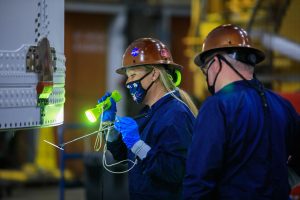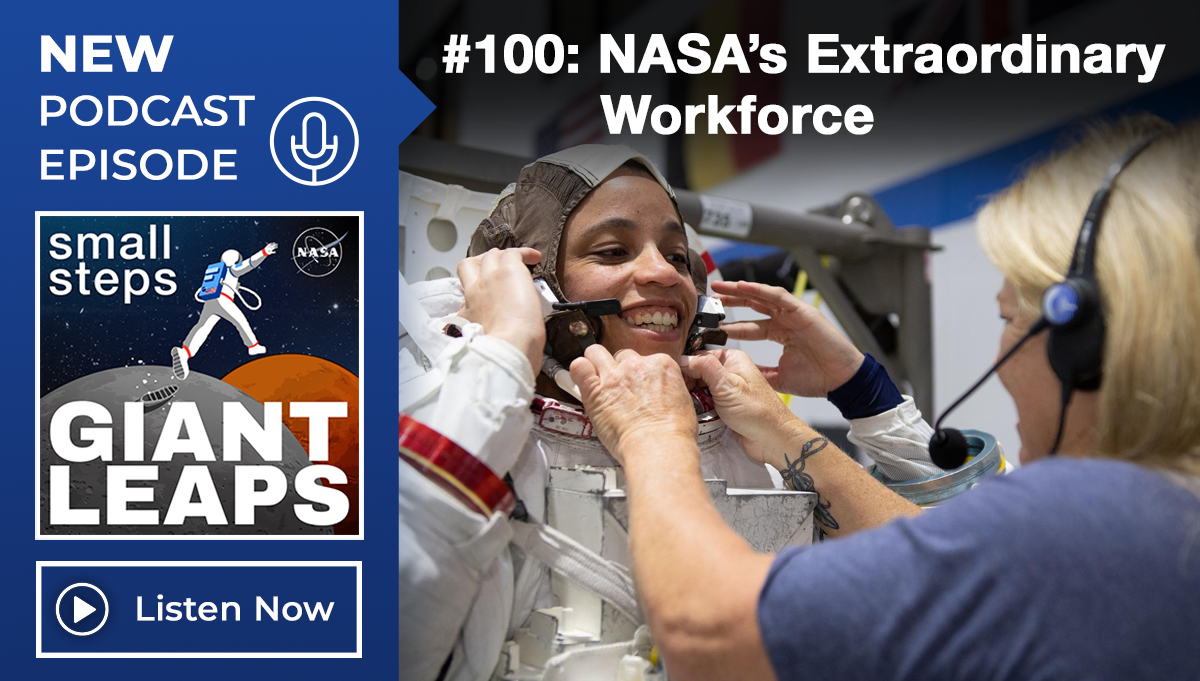
NASA’s Space Launch System (SLS) rocket and Orion spacecraft, standing atop the mobile launcher, arrive at Launch Pad 39B at the agency’s Kennedy Space Center in Florida on Nov. 4, 2022, ahead of the uncrewed Artemis I launch.
Credit: NASA/Kim Shiflett
Artemis already creating jobs, creating economic output.
On Sunday, December 11, 2022, the Orion spacecraft from Artemis I, traveling more than 24,000 mph, successfully hit an exceptionally narrow window in Earth’s atmosphere and began a scorching, 76-mile descent to the planet’s surface, its heat shield at times reaching 5,000 °F. Slowed by three large parachutes, Orion splashed down just off the coast of Baja California, where it was recovered by the USS Portland after two hours of testing and photography.
Artemis I marks a key step in NASA’s Moon to Mars effort, which will revolutionize space exploration, establishing a long-term human presence at the Moon, with astronauts and robotics combining to discover more about the origins and early history of the solar system and demonstrating new technologies that will enable astronauts to live safely for prolonged periods of time in deep space, on the surface of the Moon, and eventually, enroute to, and on the surface of Mars.

Teams rolled out, or moved, the completed core stage from NASA’s Michoud Assembly Facility in New Orleans to the barge in preparation for the SLS rocket’s core stage Green Run test series at Stennis.
Credit: NASA/Eric Bordelon
Before Artemis I could be launched on it 25-day, 1.4-million-mile odyssey, the Orion spacecraft and the Space Launch System (SLS) components traveled widely across the United States, undergoing extensive testing at specialized NASA facilities to prepare for the mission. Orion was shipped to NASA’s Neil A. Armstrong Test Facility in Ohio for thermal vacuum testing that simulates space. Orion’s parachute system was tested at the U.S. Army’s Yuma Proving Ground in Arizona. The SLS’s structural system was tested at NASA’s Marshall Space Flight Center in Huntsville, Alabama. NASA shipped the SLS via barge to Stennis Space Center near Bay St. Louis, Mississippi for a Green Run test that simulated the eight-minute launch and ascent into space. The components were assembled for flight at Kennedy Space Center in Florida.
This testing demonstrates that NASA’s work on Artemis spans the nation. And, although the Artemis generation’s contributions to space exploration are years and decades in the future, the foundational work for these achievements has been underway for more than a decade, with profound implications for the U.S. economy, which is already benefiting from NASA’s efforts to push the boundaries of human space exploration. In October, NASA released an economic impact report that quantified the effects that the Moon to Mars effort had on the U.S. economy in FY 2021.
The report was prepared by The Nathalie P. Voorhees Center for Neighborhood and Community Improvement (Voorhees Center), an applied research and technical assistance unit in the College of Urban Planning and Public Affairs at the University of Illinois Chicago. It looks at NASA’s impact on each U.S. state and breaks out the impact of Moon to Mars, as well as NASA’s efforts on climate change.
“The analysis uses a standard national economic input-output model that has been in existence and tested for more than 50 years,” NASA Administrator Bill Nelson wrote in the forward. “In many ways, those numbers are conservative since the overall economic impact of NASA is truly far greater than what any one number can ever hope to convey.”
Researchers found that NASA’s economic impact is extensive, touching all 50 states. In FY21, when NASA’s budget was $23.27 billion, the agency generated a total economic output of more than $71.2 billion, with research and development activity rippling through the broader national economy, and NASA-developed technologies leading to increased productivity for U.S. businesses.
“The impact estimates reported in this study are the sum of three channels of economic impact: (1) the direct contribution of NASA’s own activities; (2) indirect (contracting) activities within NASA’s U.S. supply chain; and (3) the induced effect that results as federal civil servants at NASA facilities, employees of contractors, and employees within the supply chain of those contractors spend their wages in the wider consumer economy,” the report states.

Exploration Ground Systems technicians inspect the Orion spacecraft for NASA’s Artemis I mission, as it is lifted on Oct. 20, 2021, for transfer into High Bay 3 of the Vehicle Assembly Building at NASA’s Kennedy Space Center in Florida.
Credit: NASA/Frank Michaux
Researchers found that Moon to Mars spending supported more than $20.1 billion in total economic output across the country in FY 2021. That’s up significantly—42.6 percent—from FY 2019 levels and represents about 28 percent of NASA’s overall economic output. Moon to Mars funds support more than 93,700 jobs.
NASA’s overall economic output is highest in California, home to the Jet Propulsion Laboratory, Ames Research Center, Armstrong Flight Research Center, and a robust commercial space industry. NASA’s economic output in the state is $15.2 billion. Texas, with Johnson Space Center, is second with $9.2 billion in economic output. Alabama, Florida, and Virginia round out the top five, with Colorado in sixth place.
NASA’s economic output from Moon to Mars work is strongest in the same states, but the order is changed. Alabama, home to the Marshall Space Flight Center, leads the list at $4.9 billion, followed by Texas at $3.1 billion, Colorado at $3.0 billion, California at $2.8 billion, and Florida at $2 billion.
As a global leader in climate change research and technology development, NASA’s economic output in that sector totaled $7.4 billion in the U.S. and supported more than 37,000 jobs in FY 2021.
“NASA’s economic impact is seen in the resurgence of the U.S. commercial space economy, which is seeing unprecedented levels of private investment and growth,” Sen. Nelson wrote. He noted that $15 billion in private investments in space start-up companies in 2021 are largely attributable to NASA’s strong support of the domestic commercial space industry through partnerships, contracts, and technology transfers.
“As time passes, it may well be that some of the most important NASA contributions to our economy come from activities we are barely even aware of today,” Sen. Nelson concluded. “But we already know of innumerable ways in which NASA’s economic impact is strong—and getting stronger.”
For more information, read the NASA press release, or see the complete report.









